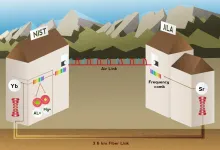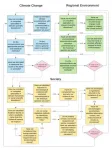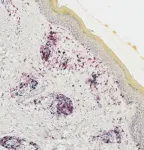(Press-News.org) Despite aquaculture's potential to feed a growing world population while relieving pressure on badly depleted oceans, the industry has been plagued by questions about its environmental impacts. (Watch related video: https://www.youtube.com/watch?v=DG_nl7-naYo)
But over the years, the diverse industry - which ranges from massive open-ocean salmon cages to family farm freshwater tilapia ponds - has made significant strides toward sustainability, according to a new Stanford-led analysis.
The study notes, however, that in order for the global aquaculture sector to deliver on its full promise, more effective oversight measures are needed to help ensure that its environmentally sound systems are economically viable.
The findings, published March 25 in Nature, could help shape how consumers think about the seafood they buy, and inform governance strategies critical to global food and nutrition security.
"As the demand for seafood around the world continues to expand, aquaculture will keep growing," said study lead author Rosamond Naylor, the William Wrigley Professor of Earth System Science in Stanford's School of Earth, Energy & Environmental Sciences (Stanford Earth). "If we don't get it right, we risk the same environmental problems we've seen in land-based crop and livestock systems: nutrient pollution, excessive use of antibiotics and habitat change that threatens biodiversity."
Twenty years ago, Naylor led a study that sparked controversy by saying farmed fish and shellfish in some cases added pressure to ocean fisheries - instead of relieving it - because carnivorous farm-raised species required large amounts of wild fish for feed. The paper, also published in Nature, prompted a spate of news stories and academic research questioning whether aquaculture was more of an environmental problem than a solution. Environmental groups applauded the study's focus on aquaculture's marine ecosystem impacts, while the industry pointed to hopeful developments that were largely ignored, such as ongoing improvements in fish nutrition.
Since then, the volume of global aquaculture production has tripled. In the new paper, aquaculture specialists and scientists from Asia, Europe, South America and the U.S. assessed the state of the industry by synthesizing hundreds of studies done over the past two decades on issues ranging from value chain developments in freshwater aquaculture to the use of wild fish in feeds to seaweed market challenges.
Their analysis considered key challenges and uncertainties, such as climate change's impact on the industry, low-income producers' adoption of sustainable seafood certification programs and shellfish and seaweed farmers' ability to profit from providing ecosystem services, such as carbon capture.
Among the findings: freshwater aquaculture, comprised of nearly 150 species of fish, shellfish and plants, accounts for 75% of farmed aquatic food consumed directly by humans.
"Most aquaculture is about fish people can afford to eat - and most of the farming of aquatic animals happening in Asian countries stays in those countries," said study co-author David Little, a professor in the University of Stirling Institute for Aquaculture, in the U.K. "It's having an important impact on food security and rural livelihoods."
Other regions, including Africa, are increasingly benefitting from the introduction of freshwater aquaculture. But while small freshwater farms are on the rise around the world, there is little oversight of their practices.
The researchers also found that the production of high-value shrimp, salmon and other marine fish rose rapidly, contributing to a significant rise in the share of global fishmeal and fish oil used by aquaculture. Yet, the ratio of wild fish input per fed fish output has dropped almost seven-fold since 1997.
"We have been successful in converting carnivorous fish, such as salmon and trout, largely into vegetarians," said study co-author Ronald Hardy of the Aquaculture Research Institute at the University of Idaho.
In the study, the researchers call for better management of antimicrobial use in fish farming to limit the development of drug-resistant microbes that threaten both fish and human health, and regulation of marine farm sites. They also recommended incentives for sustainably designed systems to prevent cross-contamination between fish waste and surrounding waters, and a food systems approach to governance that considers nutrition, equity, justice and environmental outcomes and trade-offs across land and sea.
"When done well, aquaculture can play a sustaining role in global food systems by providing expanded food production and livelihood benefits with relatively minimal environmental harm," said study co-author Dane Klinger, director of aquaculture at Conservation International and PhD graduate of Stanford's Emmett Interdisciplinary Program in Environment and Resources. "This assessment will help industry, government and other stakeholders navigate the opportunities and obstacles that remain ahead."
INFORMATION:
The researchers will share observations from their analysis in a related seminar on March 30.
Naylor is also Founding Director of Stanford's Center on Food Security and the Environment; and a senior fellow in the Stanford Woods Institute for the Environment and the Freeman Spogli Institute for International Studies. Other co-authors of the study include Alejandro Buschmann of the Universidad de Los Lagos (Chile); Simon Bush of Wageningen University (Netherlands); Ling Cao of Shanghai Jiao Tong University (China); Jane Lubchenco of Oregon State University; Sandra Shumway of the University of Connecticut; and Max Troell of the Beijer Institute and Stockholm University (Sweden).
Funding for the research was provided by Stanford's Center on Food Security and the Environment.
-30-
In a significant advance toward the future redefinition of the international unit of time, the second, a research team led by the National Institute of Standards and Technology (NIST) has compared three of the world's leading atomic clocks with record accuracy over both air and optical fiber links.
Described in the March 25 issue of Nature, the NIST-led work is the first to compare three clocks, based on different atoms, and the first to link the most advanced atomic clocks in different locations over the air. These atomic clock comparisons place the scientific community one step closer to meeting the guidelines for redefinition of the second.
"These comparisons are really defining ...
Carbon dioxide in the atmosphere fuels plant growth. As carbon levels rise, it's appealing to think of supercharged plant growth and massive tree-planting campaigns drawing down the CO2 produced by fossil fuel burning, agriculture and other human activities.
New research published March 24 in Nature, however, suggests that when elevated carbon dioxide levels drive increased plant growth, it takes a surprisingly steep toll on another big carbon sink: the soil.
One likely explanation, the authors say, is that plants effectively mine the soil for nutrients they need to keep up with carbon-fueled growth. Extracting the extra nutrients requires revving up microbial activity, which then releases CO2 into the atmosphere that might otherwise remain locked in soil.
The findings contradict ...
The secret to building superconducting quantum computers with massive processing power may be an ordinary telecommunications technology - optical fiber.
Physicists at the National Institute of Standards and Technology (NIST) have measured and controlled a superconducting quantum bit (qubit) using light-conducting fiber instead of metal electrical wires, paving the way to packing a million qubits into a quantum computer rather than just a few thousand. The demonstration is described in the March 25 issue of Nature.
Superconducting circuits are a leading technology for making quantum computers because they are reliable and easily mass produced. But these circuits must operate at cryogenic temperatures, and schemes for wiring them to room-temperature electronics are complex and prone to ...
As the signs of today's human-caused climate change become ever more alarming, research into the ways past societies responded to natural climate changes is growing increasingly urgent. Scholars have often argued that climatic changes plunge communities into crisis and provide the conditions that lead societies to collapse, but a growing body of research shows that the impacts of climate change on past populations are rarely so straightforward.
In a new paper published in Nature, scholars in archaeology, geography, history and paleoclimatology present a framework for research into what they term 'the History of Climate and Society' (HCS). The framework uses a series of ...
LEBANON, NH - Some melanoma patients respond very well to immunotherapy, experiencing profound and durable tumor regression. A fraction of these patients will also develop autoimmunity against their normal melanocytes--the cells that give rise to melanoma--a phenomenon called vitiligo. Melanoma survivors with vitiligo have long been recognized as a special group with an outstanding prognosis, and a strong response of immune system cells called T cells.
Immunotherapy researchers at Dartmouth's and Dartmouth-Hitchcock's Norris Cotton Cancer Center (NCCC) led by Mary Jo Turk, PhD, and surgical oncologist Christina Angeles, MD (now of University of Michigan), have discovered how a subset ...
The ocean is dynamic in nature, playing a crucial role as a planetary thermostat that buffer global warming. However, in response to climate change, the ocean has generally become stabler over the past 50 years. Six times stabler, in fact, than previously estimated--as shown by a new study that researchers from the CNRS, Sorbonne University, and IFREMER have conducted within the scope of an international collaboration.* Warming waters, melting glaciers, and disrupted precipitation patterns have created an ocean surface layer cut off from the depths. Just as oil and ...
Training babies' brains and bodies might delay the onset of Rett syndrome, a devastating neurological disorder that affects about 1 in 10,000 girls worldwide.
In experiments with mice that replicate the genetic disorder, scientists discovered that intense behavioral training before symptoms develop staves off both memory loss and motor control decline. Compared to untrained mice, those trained early in life were up to five times better at performing tasks that tested their coordination or their ability to learn, Howard Hughes Medical Institute Investigator Huda Zoghbi and her colleagues report March 24, 2021, in the journal Nature.
Those data, from animals whose symptoms closely mimic the human disease, offers a clear rationale for genetically screening newborns for Rett syndrome, ...
New York, NY (March 24, 2021) -- Immunotherapy is not only significantly less effective in liver cancer patients who previously had a liver disease called non-alcoholic steatohepatitis (NASH), but actually appears to fuel tumor growth, according to a Mount Sinai study published in Nature in March. NASH affects as many as 40 million people worldwide and is associated with obesity and diabetes.
The researchers led a large international collaboration to investigate immunotherapy's effect on hepatocellular carcinoma (HCC), a deadly liver cancer, caused by NASH. They conducted a meta-analysis ...
New scientific findings bring hope that early training during the presymptomatic phase could help individuals with Rett syndrome, a neurodevelopmental disorder, retain specific motor and memory skills and delay the onset of the condition. Researchers at Baylor College of Medicine and the Jan and Dan Duncan Neurological Research Institute at Texas Children's Hospital reported in the journal Nature that, in a mouse model of Rett syndrome, intensive training beginning before symptoms appear dramatically improved the performance of specific motor and memory tasks and substantially delayed the appearance of symptoms.
The researchers propose that newborn genetic testing for Rett syndrome, followed by prompt intensive training in the skills that will be affected, such ...
Immunotherapy using checkpoint inhibitors is effective in around a quarter of patients with liver cancer. However, to date, physicians have been unable to predict which patients would benefit from this type of treatment and which would not. Researchers from the German Cancer Research Center have now discovered that liver cancer caused by chronic inflammatory fatty liver disease does not respond to this treatment. On the contrary: in an experimental model, this type of immunotherapy actually promoted the development of liver cancer, as now reported in the journal Nature.
Liver cancer is the sixth most common type of cancer in the world, ...




